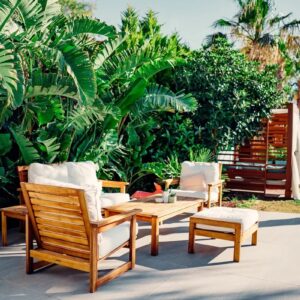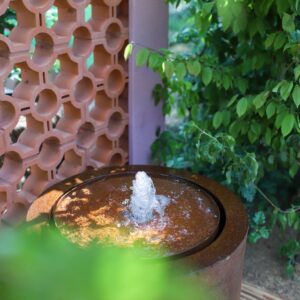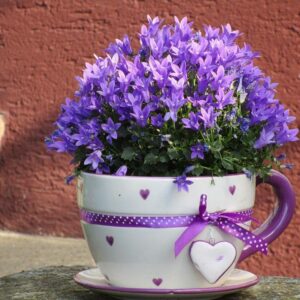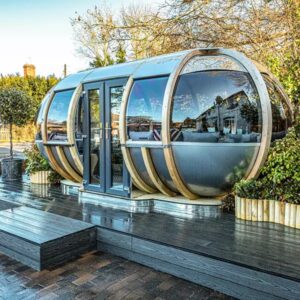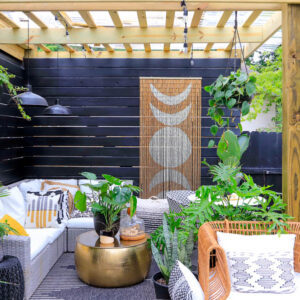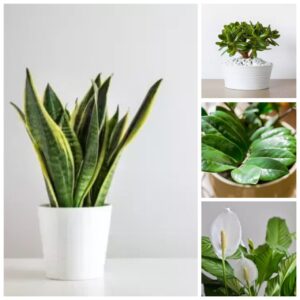In most color research, whether it’s casual polls of crayon-obsessed kids or scientific studies on color theory and marketing, blue comes out on top: It’s nearly everyone’s favorite color, according to the BBC. And whether you’re painting a nursery or playroom, a kitchen or bathroom, a living room or bedroom, the incredibly broad spectrum of this beloved shade hits just the right tone in any space.
“Blue is one of the most versatile colors in your design arsenal,” says Bobby Berk, design expert and host of Queer Eye, and author of the upcoming book Right at Home: How Good Design is Good for the Mind. “Depending on the shade, it can evoke everything from dramatic flair to a sense of serenity, classic appeal, or easy elegance. Since the color can create so many distinct moods and can work with so many different styles, it also makes it a timeless choice.”
Though blue never goes out of style, the depth and undertones of the most popular choices do shift along with design trends. “At the moment, I see interiors moving toward deeper shades of blue-gray, which adds a real sense of modern sophistication, as well as light pale blues that bring lightness and relaxation,” says Berk. “Everyone wants to feel something when they enter a space, and these shades of blue can really elicit an emotional response and set the tone for a room.”
Blue-Black
While the word “blue” often conjures images of bright summer skies and deep, clear oceans, the darker end of the spectrum offers blue-grays and almost-blacks with rich undertones that add warmth. “It’s especially the darker end of this color family that resonates with so many people, as confidence in decorating means we are more comfortable painting our interiors in dramatic color,” says Patrick O’Donnell, international brand Ambassador for Farrow & Ball. He recommends Inchyra Blue for a bold accent in transitional spaces: “Inchyra Blue never feels cold, [and is] a fantastic color for a poorly lit hall where, by playing to the light limitations, you create this wonderful, moody atmosphere,” he says. “It also acts (as many darks do) as a great background for hanging pictures that really allows your art to sing.”
Another popular Farrow & Ball shade is Railings, “our blackest of blues,” says O’Donnell. “This is always a great choice for a front door where the exterior eggshell finish will only enhance the blue undertone behind this smart dark. It also makes a rather smart choice for trim, especially when paired with a paler blue such as Selvedge on your walls.”
Sue Wadden, director of color marketing at Sherwin-Williams, recommends soothing Mount Etna, an “ashy” blue with slate-and-green undertones. “Homeowners love this sophisticated option for cabinetry, fireplaces, and accent walls,” she says.
Navy Blue
Sharp, tailored navy works as a backdrop for natural fibers, bright accents, and neutral furnishings in a home with a casual coastal aesthetic—or in a more formal modern space. “Navy blue feels luxurious and relaxing at the same time and is incredibly versatile when it comes to various design styles and tastes,” says Wadden. “This deep blue pairs well with the natural materials that have come into favor recently, such as marble, metallics, and textiles commonly used in coastal décor.” The brand’s color of the year, Naval, is one option: “Naval’s depth creates a rich background for the colors of any home to unfold,” says Wadden. “Whether you’re a minimalist or maximalist, this easy-to-use hue has a knack for tying everything together.”
Berk relies on the “deep, inky blue” of Benjamin Moore’s North Sea, his go-to navy: “I love this for a cozy living room or even kitchen cabinetry,” he says. For a deep blue with a greener undertone, interior designer Kelly Finley of Joy Street Design likes the teal undertones of Benjamin Moore River Blue (“This is great in a bedroom to make it sultry and intimate,” she says), while O’Donnell recommends Farrow & Ball’s Hague Blue, one of the company’s best-sellers. “The subtle green note stops this blue from feeling too cold and is extraordinarily versatile in use,” he says.
Finley also recommends “vibrant and rich” Majorelle Blue, an iconic shade with purple-and-navy undertones created by artist Jacque Majorelle for the Majorelle Garden in Marrakech, as a striking accent shade; Bristol Paint sells an iteration. “I would love to use it on a bookcase or in a powder room,” she says. “It also would look amazing on an entry door.”
- Sherwin-Williams Naval
- Benjamin Moore North Sea
- Benjamin Moore River Blue
- Farrow & Ball Hague Blue
- Bristol Paint Majorelle Blue
Mid-Range Blue
Mid-range blues offer the same versatility as their darker cousins—without the bold commitment. Farrow & Ball De Nimes is a perfect example, says Berk: “This medium blue is kind of like your favorite pair of denim jeans: It just looks good with everything,” he says. “For a blue shade with a more greenish hue, I opt for Benjamin Moore Apollo Blue, [which] feels both modern and classic. It would work beautifully in a dining room, bedroom, or office.”
Finley often turns to Bellbottom Blues or Water’s Edge, both from Benjamin Moore. “Bellbottom Blues is a great safe blue—it has gray undertones and doesn’t read too bold,” she says. “This would be great in a teen’s room or on cabinets when you’re trying to add color, but are scared to go bold. Water’s Edge feels sophisticated, but also demure; depending on the time of the day, it reads as more gray, but with the right companions, you can bring out the blue undertones. I recently painted my entire bedroom—ceiling, walls, and trim—in this color, and absolutely love it!”
One of Sherwin-Williams’s most popular blues is slate-inspired Stardew, says Wadden. “This shade of blue is popular due to its calm and serene nature,” she says. “Stardew’s breezy energy fills the room with bluish-gray color that reminds people to slow down and enjoy the time being spent in a space.” Oval Room Blue, a social media darling from Farrow & Ball, would work as well in Elizabeth Bennet’s home as it would in yours, says O’Donnell. “A beautifully nuanced regency blue, this color has universal appeal—as many mid-weight blues do—but this timeless color adds sophistication to any room, and a lovely weight to an east-facing bedroom, where it will respond to the natural light.”
- Farrow & Ball De Nimes
- Benjamin Moore Apollo Blue
- Benjamin Moore Bellbottom Blues
- Benjamin Moore Water’s Edge
- Sherwin-Williams Stardew
- Farrow & Ball Oval Room Blue
Pale Blue
The palest aquas, teals, and bluish-grays allow you to create a space that’s as cozy as a cloudy day or as peaceful as a lakeside picnic. “Sherwin-Williams’ North Star is a light, cool blue that just exudes a calming energy and is ideal for bedrooms and bathrooms,” says Berk. Wadden also suggests the brand’s Silvermist, a blend of blue, gray, and green. “Whether it’s other paint colors or a collection of accessories, this transitional shade makes it easier than ever to mix warm and cool tones together,” she says.
For a classic light blue that doesn’t read too juvenile, Finley turns to Benjamin Moore Sea View, a muted, well-balanced shade that’s fun and fresh—without being mistaken for baby blue—and that works especially well as a ceiling accent. And for O’Donnell, Farrow & Ball’s aptly named Light Blue is a winning color in any room. “Light Blue, a complex mid- to light blue that, depending on the natural light entering a room, can shift from a pale steel through to green, is an absolute gem of a color,” he says. “It sits beautifully with wood tones in a living room or dining room, creates a restful background for a bedroom, and loves to be layered with other colors.”
:max_bytes(150000):strip_icc():format(webp)/pittsburgh-home-tour-dining-room-cbc2936b-0220-b1e3c0d349dd4e92b3a572cb616f09b2-horiz-c94ad319d0e047fba3f63900f0b17426.jpg)
:max_bytes(150000):strip_icc():format(webp)/glen-road-home-tour-office-0220-a18b9573a57b48809795c6c3fee7ad7a-horiz-bd9754df4ce74bd994d99c588070505b.jpg)
:max_bytes(150000):strip_icc():format(webp)/colorful-texas-home-tour-tv-room-0120-0602f74d6fb64fac89c9ea237b8c1b89.jpg)
:max_bytes(150000):strip_icc():format(webp)/colorful-texas-home-tour-kitchen-0120-ca0195f7650a4e298aef7a7bc8426268.jpg)
:max_bytes(150000):strip_icc():format(webp)/house-tour-10beechave_273-0519-44f28370c3d747e49ff8c70dabf7a3b8-horiz-48f20951447541adb9de675153e47341.jpg)
